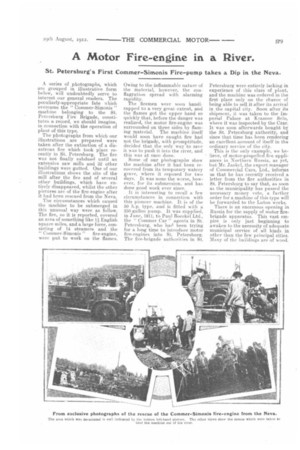A Motor Fire-engine in a River.
Page 9

If you've noticed an error in this article please click here to report it so we can fix it.
St. Petersburg's First Commer—Simonis Fire—pump takes a Dip in the Neva.
A series of photographs, which are grouped in illustrative form below, will undoubtedly serve to interest our general readers. The peculiarly-appropriate fate which overcame the " Commer-Simonis " machine belonging to the St. Petersburg Fire Brigade, constitutes a record, we should imagine, in connection with the operation of plant of this type.
The photographs from which our illustrations are prepared were taken after the extinction of a disastrous fire which took place recently in St. Petersburg. The fire was not finally subdued until an extensive saw mills and 32 other buildings were gutted. One of our illustrations shows the site of the mill after the fire and of several other buildings, which have entirely disappeared, whilst the other pictures are of the fire engine after it had been rescued from the Neva.
The circumstances which caused the machine to be submerged in this unusual way were as follow. The fire, so it is reported, covered an area of something like 1A English square miles, and a large force, consisting of 14 steamers and the " Commer-Simonis " fire-engine, were put to work on the flames.
Owing to the inflammable nature of the material, however, the conflagration spread with alarming rapidity. The firemen were soon handicapped to a very great extent, and the flames got the upper hand so quickly that, before the danger was realized, the motor fire-engine was surrounded on three sides by flam
ing material. The machine itself would soon have caught fire had not the brigade, with promptitude, decided that the only way to save it was to push it into the river, and this was at once done.
Some of our photographs show the machine after it had been recovered from its temporary watery grave, where it reposed for two days. It, was none the worse, however, for its submersion, and has done good work ever since.
It is interesting to recall a few circumstances in connection with this pioneer machine. It is of the 50 h.p. type, and is fitted with a 350-gallon pump. It was supplied, in June, 1911, to Paul Boeckel Ltd., the " Commer Car " agents in St. Petersburg, who had been trying for a long time to introduce motor fire-engines into St.. Petersburg. The fire-brigade authorities in St. Petersburg were entirely lacking in experience of this class of plant,
and the machine was ordered in the first place only on the chance of being able to sell it after its arrival in the capital city. Soon after its shipment, it was taken to the Imperial Palace at Krasnoe Selo, where it was inspected by the Czar. It was soon afterwards bought by the St. Petersburg authority, and since that time has been rendering an excellent .areount of itself in the ordinary service of the city.
This is the only example, we believe, of motor-propelled fire appliances in Northern Russia, as yet, hut Mr. Jaekel, the export. manager of Commercial Cars, Ltd., informs us that he has recently received a. letter from the fire authorities in St. Petersburg to say that, as soon as the municipality has passed the necessary money vote, a further order for a machine of this type will be forwarded to the Luton works.
There is an enormous opening in Russia for the supply of motor firebrigade apparatus. This vast empire is only just beginning to awaken to the necessity of adequate municipal service of all kinds in other than the few principal cities. Many of the buildings are of wood.






















